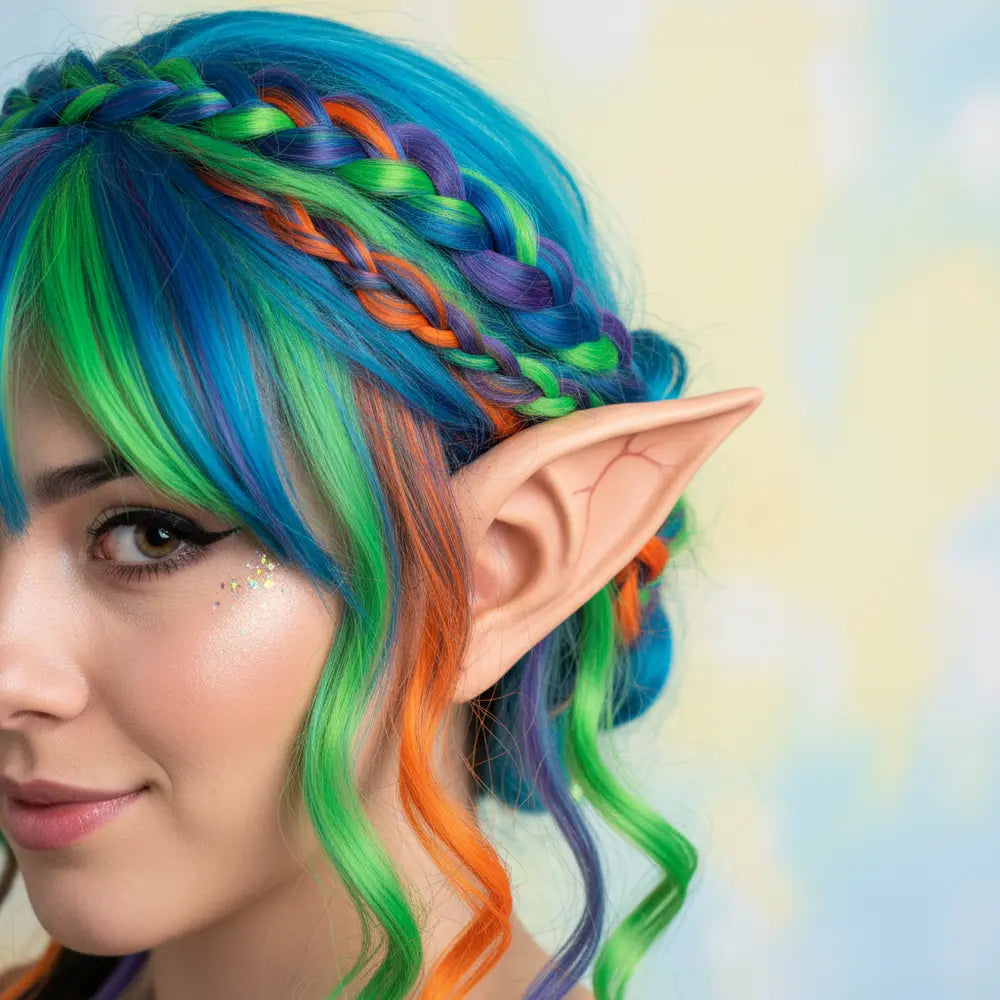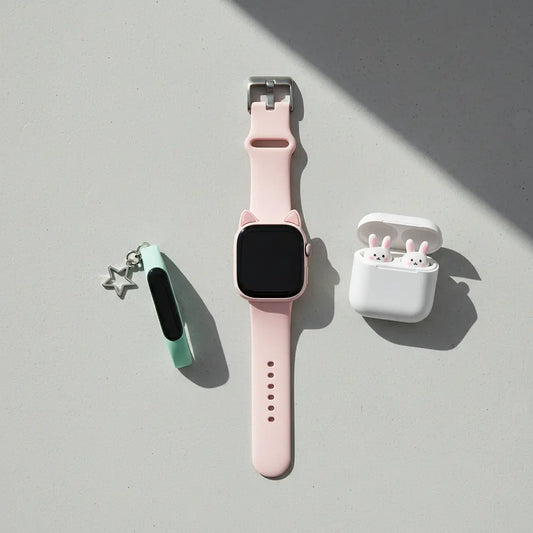
How to Secure Cosplay Ears to Wigs Easily
How to Secure Cosplay Ears to Wigs Easily
You’re at a convention, your wig is flawless, and your costume is getting compliments. You pose for a photo, and then it happens—one of your cosplay ears slides down the side of your wig, dangling awkwardly. Sound familiar? That sinking feeling of a costume malfunction can ruin a perfect moment.
For many cosplayers, especially when starting out, figuring out how to attach cosplay ears to a wig is a huge source of stress. You want a seamless, natural look, but more importantly, you need a cosplay ears secure fit that lasts through a full day of walking, posing, and excitement. A visible headband can disrupt the entire character illusion.

This guide is your complete playbook for solving that problem. We’ll explore four reliable methods: glue, magnets, clips, and sewing. We'll break down the pros and cons of each, so you can choose the best approach for your specific character, wig type, and comfort level.
Let’s get your ears locked in place so you can focus on having an amazing con experience.
Why Your Cosplay Ears Keep Slipping Off (and How to Fix It)
Ever wonder why your carefully placed ears seem to have a mind of their own? This section explains the common reasons for slippage and gives you the foundational knowledge to prevent it from ever happening again.
The struggle is real. According to informal polls on cosplay forums, over 70% of cosplayers report costume malfunctions as a top convention stressor, with slipping accessories being a primary culprit. The issue isn't your fault; it's usually a matter of physics and materials.
The Main Culprits
- Weight vs. Grip: Heavy ears made of resin or thick foam exert more downward force. If the attachment point is small or the wig surface is slick, gravity will always win. The weight of the ear must be matched with an attachment method strong enough to support it.
- Wig Fiber Texture: Synthetic wig fibers are notoriously smooth and non-porous. This means adhesives like spirit gum, which work great on skin, have very little to grip onto. The glue sits on the surface instead of bonding with it, leading to failure.
- Headband Visibility: The easiest solution is often a headband, but it's rarely the most aesthetic. A visible plastic or fabric band can instantly break the character's silhouette, which is why so many cosplayers search for options for cosplay ears without a headband.
- Wig Construction: The type of wig matters. A hard-front wig provides a solid base near the hairline, but a lace front wig requires a more delicate touch. Puncturing the lace with sewing can damage it, and glue can leave a visible, hard residue. Understanding your wig's structure is the first step to choosing the right method.
Method 1: The Strategic Glue-Down
Thinking glue is the simplest answer but worried about the mess or a weak hold? Here, we demystify which adhesives actually work on wigs and show you the right way to apply them for a bond that won’t quit.
Using glue can be a fantastic and surprisingly durable option when you choose the right type and apply it correctly. The common mistake is grabbing any craft glue and hoping for the best. For cosplay, you need adhesives designed for specific materials and stresses.
Pro-Tip: A pro-tip shared by veteran cosplayers is to always perform a patch test. Apply a small dot of your chosen glue to a hidden area of your wig (like the underside wefts) and a scrap of your ear material. Let it dry completely to check for discoloration, melting, or a weak bond.
Best Glue Types for Cosplay Ears
- •Latex Adhesive: If your ears are made of latex (common for elf or fantasy ears), liquid latex is your best friend. It creates a strong, flexible bond by essentially fusing the latex ear base to a matted section of wig fiber.
- •Silicone Adhesive (e.g., Sil-Poxy): For silicone ears, you need a silicone-based glue. Silicone is notoriously resistant to other glues. Sil-Poxy is an industry standard that creates a powerful bond specifically for silicone parts.
- •Industrial Strength Glue (e.g., E6000): This is a powerful, flexible, and waterproof option for attaching a fabric or solid base to a wig. Warning: Use it in a well-ventilated area. It's best for creating a permanent bond, so be sure of your placement.
Application Technique for a Lasting Hold
- Prep the Area: Identify exactly where the ear will sit. Use a small comb to slightly tease or matt the wig fibers in that spot. This creates a rougher surface for the glue to grip.
- Apply Glue to the Ear: Apply a thin, even layer of your chosen adhesive to the base of the cosplay ear. Avoid large globs, which take longer to dry and can look messy.
- Press and Hold: Firmly press the ear onto the prepped spot on the wig. Hold it in place for several minutes, or use clips to secure it while it cures.
- Curing Time: This is the most crucial step. Most industrial glues need 24-72 hours to fully cure and reach maximum strength. Don't try to wear the wig an hour after gluing!
Pros and Cons of the Glue Method
Pros:
- Can create a very strong, permanent bond.
- Excellent for creating a seamless, blended look with no visible hardware.
- Cost-effective, as a single tube of glue can be used for multiple projects.
Cons:
- Often permanent, making it difficult to adjust or remove the ears.
- Can damage wig fibers if applied or removed incorrectly.
- Requires long curing times and good ventilation.
Method 2: The Magic of Magnets
Wish you could just snap your ears into place and have them stay put all day? This section walks you through using magnets, the cleverest way to get a super-strong, removable, and completely hidden cosplay ear attachment.
Magnets are a game-changer for attaching accessories. They offer incredible strength while allowing you to easily remove your ears for transport or storage. The secret is using rare-earth magnets, like neodymium magnets, which have a powerful pull force relative to their small size.
Think of it like an invisible anchor system. One magnet is embedded inside the wig, and its partner is embedded in the base of the ear. When they get close, they snap together with a satisfying "click," locking the ear firmly in place through the wig fibers.
DIY Magnetic Cosplay Ears: Step-by-Step
Creating DIY magnetic cosplay ears is surprisingly simple. You just need a set of strong, flat neodymium magnets (around 1/2 inch or 12mm diameter is a good start), some sturdy fabric like felt or buckram, and a strong adhesive like E6000.
- Create the Interior Anchor: Glue a magnet onto a small, stiff piece of fabric (the anchor). This prevents the magnet from getting lost in the wig hair.
- Position the Anchor: Place the wig on a wig head. Position the fabric anchor on the inside of the wig cap, right where you want the ear to sit.
- Secure the Anchor: Sew or glue the fabric anchor securely to the wig's internal wefts or cap structure. This is the foundation of the entire system.
- Prepare the Ear: Glue the second magnet to the base of your cosplay ear. Crucial: Double-check the polarity! Make sure the side of the magnet you're gluing down is the one that repels the anchor magnet, so the correct side faces out.
- Test the Connection: Once the glue is fully cured, simply bring the ear close to the correct spot on the outside of the wig. It should snap firmly into place.

For a definitive, step-by-step visual guide on this exact technique, the best resource is our article on the Magnetic Cosplay Ears Tutorial. It’s the go-to method for a perfect cosplay ears secure fit.
Read the Full Magnetic Ears TutorialDurability and Convention Use
A cosplayer reported wearing heavy, 3D-printed fox ears for a 12-hour day at Anime Expo using this exact method. The ears survived crowds, photo ops, and even a dance competition without budging. The strength of the magnetic bond is more than enough to handle the rigors of a convention.
POLL: Which method do you trust most for your ears?
Method 3: The Reliability of Clips and Sewing
Looking for a non-glue solution that feels just as secure? This part covers the time-tested techniques of using clips and sewing to integrate your ears directly with the wig for ultimate stability.
If you prefer a more physical connection or are working with heavier ears, sewing them directly to the wig or using hidden clips offers unmatched reliability. These methods physically anchor the ears to the wig's structure, making them a great choice for active characters.
While these physical methods are fantastic, some cosplayers are exploring even more advanced options. If you've ever been curious about the technology behind expressive accessories, you might be fascinated to learn what moving cat ears are and how they use tiny servos and sensors to react to your expressions. For now, let's focus on the sturdy, non-electronic approaches.
How to Sew Ears onto a Wig Securely
Sewing is the most permanent and integrated solution. It’s like making the ears an actual part of the wig. This works best for fabric or furry ears with a flexible base.
- Choose Your Thread: Use a heavy-duty upholstery thread that matches the color of your wig's roots. This will make your stitches nearly invisible.
- Find the Wefts: Place the wig on a wig head. Part the hair where you want to attach the ear and locate the horizontal rows of hair called wefts. These are your anchor points.
- The Stitching Process: Using a curved upholstery needle, begin stitching the base of the ear directly onto a sturdy weft. Use a whipstitch or a blanket stitch for a strong hold.
- Secure and Hide: Make several passes to ensure the ear is completely secure. Once finished, comb the wig fibers over the stitch line to hide your work completely.
Using Small Hidden Clips for Flexibility
For a less permanent but still very secure option, small wig clips (the kind with a comb that snaps shut) are perfect. This gives you the freedom to reposition or remove your ears.
- Attach Clips to Ears: Sew or glue one or two snap clips to the base of each ear. Make sure the comb part of the clip is facing a direction that allows it to grip the wig fibers.
- Section the Hair: On the wig, part the hair where you want the ear to sit.
- Clip and Snap: Slide the clip's comb under a weft and press down until it snaps shut. The clip will now be firmly anchored to the wig's structure.
- Style and Blend: Comb the hair over the base of the ear to hide the clip. The small profile of these clips makes them very easy to conceal.
The clip-in method is one of the most popular ways to achieve a headband-free look. If you love this approach and want to explore even more creative, non-permanent solutions, our comprehensive guide of DIY hacks to attach cosplay ears offers a wealth of additional techniques you can master.
Blending and Styling for a Natural Look
Worried about your attachments showing and ruining the magic? This section is packed with pro styling tricks to seamlessly blend your ears and hide any trace of clips, glue, or magnets.
A secure attachment is only half the battle. The final goal is to make cosplay ears look natural on the wig, as if they are truly part of the character. This is achieved through clever styling and blending of the wig fibers around the ear's base.
Think of it like applying makeup. You use foundation and contouring to blend colors and hide lines. With a wig, you use hair fibers and styling products to achieve the same seamless effect.
Hiding Your Attachment Points
- •The Hair "Canopy": After attaching your ear, take a thin section of hair from just above the ear. Gently comb it down and over the base of the ear. A light mist of hairspray can help hold it in place, creating a natural-looking transition.
- •Teasing for Volume: If there's a slight gap or a visible edge, gently backcomb the hair at the base of the ear. This creates volume that fluffs up and conceals the seam where the ear meets the wig.
- •For Furry Ears: Use a wire pet brush (a slicker brush) to gently brush the fibers of the wig and the fur at the base of the ear together. This interlocks the fibers, making the transition between the two completely seamless.

Wig Styling Tricks to Disguise Seams
Is the base of your ear still a little too obvious? Don't worry. This is where character-specific styling comes in.
- •Incorporate Accessories: Does your character wear hair clips, ribbons, or a small flower? Strategically placing an accessory near the base of the ear is a canonical way to hide any mechanical parts.
- •Creative Braiding: Braid a small section of hair that wraps around the front or back of the ear's base. This not only looks beautiful but is an incredibly effective way to hide the seam.
- •The "Root and Fluff" Technique: Take a small amount of dark eyeshadow that matches the wig's root color. Lightly dust it around the seam where the ear joins the wig. This creates a shadow effect that mimics a natural hairline or root, tricking the eye into seeing a smoother join.
Troubleshooting Common Ear-mergencies
What happens if, despite your best efforts, an ear comes loose at a con? Don't panic! This section is your emergency response plan, with quick fixes and a checklist to ensure you're always prepared.
Even with the best preparation, convention chaos can sometimes lead to a costume malfunction. The key is not to panic but to be prepared with a small, portable repair kit. Knowing you have a quick fix on hand will give you peace of mind.
Picture your emergency kit as a first-aid kit for your cosplay. It should be small enough to fit in a bag or pocket and contain just what you need to handle a sudden droopy ear situation.
Convention Emergency Repair Kit
Quick Fixes for a Falling Ear
- The Bobby Pin Brace: If an ear starts to wobble, find a quiet spot. Slide two bobby pins in an "X" shape over the base of the ear, securing it to the wig mesh below. This creates a surprisingly sturdy temporary brace.
- The Tape Trick: For lightweight latex or fabric ears, a piece of high-quality fashion tape can secure the ear for a few more hours. It won't survive vigorous movement, but it's perfect for getting you through a photoshoot.
Tips for High-Activity Events
Are you planning to enter a dance competition or a performance-heavy masquerade? You need to plan for extra security.
For intense activity, sewing is the undisputed champion of security. A well-sewn ear becomes part of the wig and will not fail. The magnetic method, when used with very strong neodymium magnets, is a close second. Avoid relying on temporary adhesives or simple clips if you know you'll be moving around a lot.
Method Comparison: Which is Right for You?
Feeling overwhelmed by the options? This quick-reference chart breaks down all four methods, comparing them side-by-side so you can confidently choose the perfect one for your cosplay.
Choosing your attachment method depends on your priorities. Do you need something permanent and indestructible, or something flexible and easy to remove? Use this chart to find your perfect match.
| Method | Best For | Skill Level | Durability | Cost |
|---|---|---|---|---|
| Glue | Lightweight latex/3D printed ears for a seamless look. | Beginner-Intermediate | High | Low |
| Magnetic | Any ear type, especially when removability is needed. The best all-around option for cosplay ears that stay on a wig all day. | Beginner | Very High | Low-Medium |
| Sewing | Heavy or large furry ears needing maximum support. | Intermediate | Extremely High | Low |
| Clips | Non-permanent solution for medium to lightweight ears. | Beginner | Medium-High | Low |
Beginner-Friendly Quick-Start Tutorial
Ready to attach your first pair of ears without the stress? This simple, step-by-step guide walks you through the easiest and most reliable method for beginners: magnets.
If this is your first time venturing into cosplay ears without a headband, the magnetic method is the perfect place to start. It's incredibly forgiving, requires no complex skills, and delivers a professional, secure result every time. We'll get you set up in just a few simple steps.
Let's imagine you're a first-time cosplayer attaching a pair of cute cat ears. You want them to look great and feel secure without any fuss.
Your Toolkit and Materials
- ✓Your wig on a foam wig head
- ✓Your cosplay ears
- ✓Two pairs of strong, flat neodymium magnets (e.g., 12mm x 2mm)
- ✓A small piece of sturdy fabric (like felt)
- ✓Strong glue (like E6000)
- ✓A needle and thread
Step-by-Step Visual Walkthrough
- Mark the Spot: Put the wig on the foam head. Place your ear on the wig to decide on the perfect position. Use a small pin to mark the spot through the wig.
- Create the Inner Anchor: Take one magnet and glue it to a small square of felt. Let it dry completely. This is your anchor.
- Attach the Anchor Inside: Turn the wig inside out. Find the spot you marked and sew the felt anchor securely to the wig's inner structure (the wefts or cap).
- Prepare the Ear: Take the second magnet and carefully glue it to the flat base of your cosplay ear. Make 100% sure the polarity is correct so it will attract, not repel, the magnet inside the wig.
- Let it Cure: Let the glue on the ear dry for at least 24 hours. Don't rush this! A fully cured bond is a strong bond.
- The Final Snap: Once dry, simply bring the ear up to the outside of the wig. You’ll feel the magnetic pull guide it into place, ending with a satisfying *snap*. Your ear is now securely attached yet fully removable.
For a more detailed breakdown with pictures and product recommendations, the most helpful guide you can read is our Magnetic Cosplay Ears Tutorial.
Your Cosplay is Now Secure
You now have a complete arsenal of techniques to ensure your cosplay ears stay perfectly in place. From the permanent bond of sewing to the clever convenience of magnets, you can now choose the method that best fits your character, your wig, and your convention plans.
The most important takeaway is to practice before the event. Do a "wear test" around the house for a few hours. This allows you to make adjustments and build confidence in your chosen method. A secure costume is the foundation of a stress-free and immersive cosplay experience.
Ready to level up other parts of your costume? Ears are just the beginning! Many are now exploring full-body accessories. Find out why fox tails are trending from conventions to everyday fashion and how they can complete your next look.
Sign up for our newsletter for more pro cosplay tips, and join our community to share your amazing creations!
Frequently Asked Questions (FAQ)
How can I attach heavy foam or resin ears to a wig?
For heavy ears, the magnetic or sewing methods are your best options. If using magnets, choose larger, stronger neodymium magnets (N52 grade). If sewing, ensure you stitch through a sturdy structural weft of the wig, not just the mesh cap, to distribute the weight.
Will spirit gum or other skin adhesives damage my lace front wig?
It is not advisable to use spirit gum directly on a lace front wig. The gum can clog the delicate lace, be very difficult to remove without damaging the fibers, and will not create a strong bond with the synthetic hair. Always use an adhesive appropriate for the materials you are bonding.
Can I make my cosplay ears detachable for easy travel?
Absolutely! The magnetic method and the clip-in method are both designed for this exact purpose. They provide a strong hold during wear but allow you to easily remove the ears for packing, which prevents them from getting crushed or damaged in transit.
What's the best way to hide the attachment point on a short wig?
On short wigs, hiding attachments requires precision. Use the magnetic method for a completely invisible internal anchor. After attaching the ear, use a small amount of wig wax or pomade to carefully style the short fibers around the base of the ear, effectively camouflaging any seam.




